What are Iris Forceps?
Iris forceps are a type of handheld surgical instrument that is commonly used in ophthalmic or eye surgeries. They have a long, slender shape with two curved ends that come together to form pointed tips. These tips often feature small serrations for better grip and precision during delicate procedures.
The name “iris” comes from the fact that these forceps were specifically designed for use in surgeries involving the iris, which is the colored part of the eye that controls the size of the pupil. However, they are now also commonly used in other types of eye surgeries, such as cataract removal and corneal transplant procedures.
Iris forceps are medical devices used to grasp and fixate the iris during ophthalmic surgery. It usually consists of a beak and a handle, the beak portion of the forceps is shaped to hold and fixate the iris, and the end of the beak usually has a fine tip to accurately hold a specific portion of the iris. The handle is usually thicker and is used to hold and manipulate the forceps.
What are the Uses of Iris Forceps?
- a laceration or contusion of the iris requiring repair.
- iris prolapse requiring repositioning during cataract surgery.
- Management of anterior chamber angle stenosis around the iris.
To use, the surgeon needs to insert the beak of the forceps into the iris and then gently clip it at the right place to adjust or repair the damaged iris. Then, wrap the forceps with sterilized gauze to facilitate surgical operation. In addition, to ensure surgical safety, care should be taken when using iris forceps to avoid pinching other eye tissues.
Please note that special iris forceps may be required for certain surgeries or specific conditions. Therefore, you should consult your doctor before use to determine which iris forceps are best suited for your surgical needs.
The main function of iris forceps is to hold the iris tissue to facilitate surgical manipulation or repositioning. Forceps are an indispensable tool in iris repair surgery. The shape of the iris forceps is generally long and curved, which helps to hold the iris tissue securely and ensures a smooth surgical procedure. In addition, some advanced iris forceps may come with attachments such as multiple angles and bifurcations to better suit the needs of the procedure.
Principle of iris Forceps
The principle of iris forceps is mainly based on the tension and viscoelasticity of the iris. Iris forceps are special surgical instruments for pinching iris tissues, which utilize the tension and viscoelasticity of the iris, are able to easily pinch the iris tissues without damaging them by means of a specific device in the forceps and a special manipulation.
The principle of iris forceps is mainly based on an in-depth knowledge of the structure and function of the iris, as well as on fine control of the design and handling of the surgical instruments.
How to Use Iris Forceps?
The method of using iris forceps is as follows:
- Clamping operation: the operator holds the forceps, inserts the head of the forceps between the iris and the eyeball, clamps the iris, and withdraws it to the desired site.
- light, rapid, avoid repeated in and out, and clamping, in order to prevent tearing the corneal epithelium.
- The diameter of the opening of the clamp should be smaller than the diameter of the iris to minimize the chance of iris tearing.
- The action should be coordinated and accurate, and should not be randomly clamped on the superficial surface of the straight blood vessels and pigmented membrane to avoid bleeding and damage to the cornea.
In addition, the axial length of the eyeball, the position, and the tilt of the eye should be judged correctly to determine the distance and depth of the clip. When encountering peripheral anterior iris adhesion, a strong dip forceps should be used to gently lift the iris at the edge of the adhesion, paying attention to the need to move gently to avoid tearing off the iris before the atrial aqueous humor flows out and leads to a decrease in intraocular pressure.
Precautions for iris forceps
When using iris tweezers, there are several precautions:
- handling must be light and careful to avoid damage to the eye.
- The tips of the iris forceps should be sharp and stored to avoid dulling them.
- when clamping the lens or vitreous body, the forceps should be placed in sterile saline to prevent drying and dulling of the iris forceps.
- Do not use the iris forceps to clip cloudy fat or other tissue fragments during surgery to prevent accidental penetration of the lens or vitreous, which can lead to surgical accidents.
- the head of forceps should be cleaned in time during use to avoid sticking to the tissue and affecting the operation.
- Soak the forceps in sterile saline after use to keep them in sterile condition.
- Note that iris forceps can only be used for holding ocular tissues in ocular surgery, and should not be used for holding operations in other parts of the body, so as not to cause injury.
Following the above precautions will ensure the safety and effectiveness of using iris forceps.
What is the Difference between Straight and Curved Iris Forceps?
Iris forceps are a commonly used instrument in ophthalmic surgeries and procedures. These delicate, fine-tipped forceps are designed specifically for handling the delicate tissue of the iris. There are two main types of iris forceps: straight and curved.
Straight iris forceps, as the name suggests, have a straight shaft with tips that meet perfectly in line with each other. This type of forceps is often preferred for tasks that require precision and accuracy, such as grasping small fragments or manipulating sutures. The straight shape allows for easy maneuverability and control, making it ideal for intricate procedures.
On the other hand, curved iris forceps have a slight curve along the shaft with tips that are angled towards each other. This curved design provides better visibility when working on areas that are difficult to reach or see, like behind structures within the eye. Curved iris forceps also allow for easier access to specific areas of the eye without having to reposition or realign the instrument constantly.
While both straight and curved iris forceps serve similar purposes, they have distinct differences in terms of their function and use during surgery. For instance, straight iris forceps are commonly used to grasp objects or tissues from a flat surface while maintaining alignment with your view through a microscope lens. Curved iris forceps excel at grabbing objects or tissues around corners without obscuring your view through a microscope.
In addition to their varying shapes, these two types of iris forceps also differ in their grip strength. Straight iris forceps provide better stability and grip strength due to their parallel alignment whereas curved ones usually offer lesser stability due to their angular tips meeting at one point only.
Why Are Iris Forceps an Essential Tool in Medical Practice?
One of the main uses of iris forceps is during ophthalmic surgeries. The fragile nature of the eye requires precise and gentle handling, making it an essential instrument for ophthalmologists. During procedures like cataract surgery or corneal transplantation, these forceps help surgeons hold onto and manipulate delicate tissues without causing any damage.
Besides ophthalmology, iris forceps also play a crucial role in other types of surgeries involving fine tissue manipulation. For instance, they are commonly used in plastic and reconstructive surgeries to carefully grasp soft tissues while performing intricate procedures.
But what makes iris forceps stand out from other surgical tools? Their unique design! These forceps have a single pointed tip with small serrations that provide a strong grip on tissues without slipping or tearing them. This design also allows for better precision and control during surgery.
Moreover, their structure makes them versatile enough to be used in both open and minimally invasive procedures. When used in laparoscopic surgeries, where incisions are smaller and the visual field is limited, specialized versions called micro-iris forceps are used due to their miniature size.
Apart from surgical use, micro iris forceps find applications in diagnostic procedures as well. For instance, they can be useful in endoscopy to retrieve biopsy samples or foreign objects from inside the body.
It’s worth mentioning that while there may be similarities between different types of tissue forceps available on the market (like dressing or anatomical), none can substitute for iris forceps when it comes to handling delicate structures like nerves and blood vessels.
When choosing an iris forceps for your medical practice or personal use, ensure you select a high-quality instrument made of the right material. Stainless steel is the preferred choice due to its durability, corrosion resistance, and ease of sterilization.
Iris forceps are an essential tool in medical practice due to their unique design and versatile applications. From ophthalmic surgeries to endoscopic procedures, they provide a safe and effective way to handle delicate tissues without compromising precision or control. So whether you’re a surgeon or someone interested in the medical field, understanding and appreciating the value of this instrument is crucial.
How do I sterilize iris forceps?
There are various methods for sterilizing iris forceps, including autoclaving, chemical disinfection, and dry heat sterilization. Each method has its advantages and is suitable for different types of forceps. Before deciding on a sterilization method, it is important to check the manufacturer’s instructions as well as any guidelines set by regulatory bodies.
Autoclaving is the preferred method of sterilizing most surgical instruments due to its efficiency and reliability. This process uses steam under high pressure to kill microorganisms present on the surface of the instrument. To properly autoclave iris forceps, follow these steps:
- Begin by cleaning the forceps thoroughly using warm water or enzymatic detergent solution to remove any residue or debris.
- Once clean, rinse the instrument with distilled water.
- Place the instrument in an approved autoclave bag ensuring there is enough room between items for steam circulation.
- Set the temperature and duration according to the manufacturer’s instructions (typically 121°C/250°F for 15 minutes).
5. Train your staff carefully if carrying out this task outside standard central services as they must monitor each parameter throughout each stage closely.
Dry heat sterilization is another commonly used method for sterilizing surgical instruments that are sensitive to moisture or cannot withstand high temperatures such as plastic handles or rubber o-rings found in some types of iris forceps. This method works by exposing instruments to high temperatures ranging from 160-190°C (320-374°F) for an extended period of time.
Chemical disinfection is another viable option for sterilizing iris forceps. This method uses liquid or gas chemical agents to eliminate microorganisms on the surface of the instrument. However, due to the complex design of iris forceps, it may be difficult to ensure complete penetration of these agents, making them less effective as compared to autoclaving or dry heat sterilization.
In addition to these sterilization methods, proper handling and storage of iris forceps are also crucial in maintaining their sterility. These instruments should only be handled by properly trained personnel using clean gloves and stored in a clean and dry environment.
Ensuring proper sterilization techniques for iris forceps is essential in preventing cross-contamination and promoting patient safety during surgical procedures. By carefully following guidelines set by regulatory bodies and manufacturers, healthcare professionals can maintain a sterile environment and provide quality care to their patients.

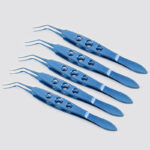 Capsulorhexis Forceps
Capsulorhexis Forceps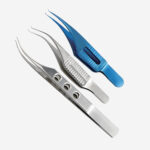 Suture Forceps
Suture Forceps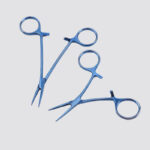 Hemostatic Forceps
Hemostatic Forceps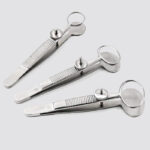 Chalazion Forceps
Chalazion Forceps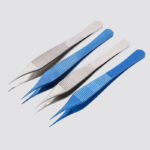 Adson Forceps
Adson Forceps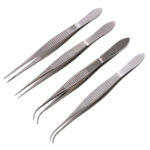 Tissue Forceps
Tissue Forceps


